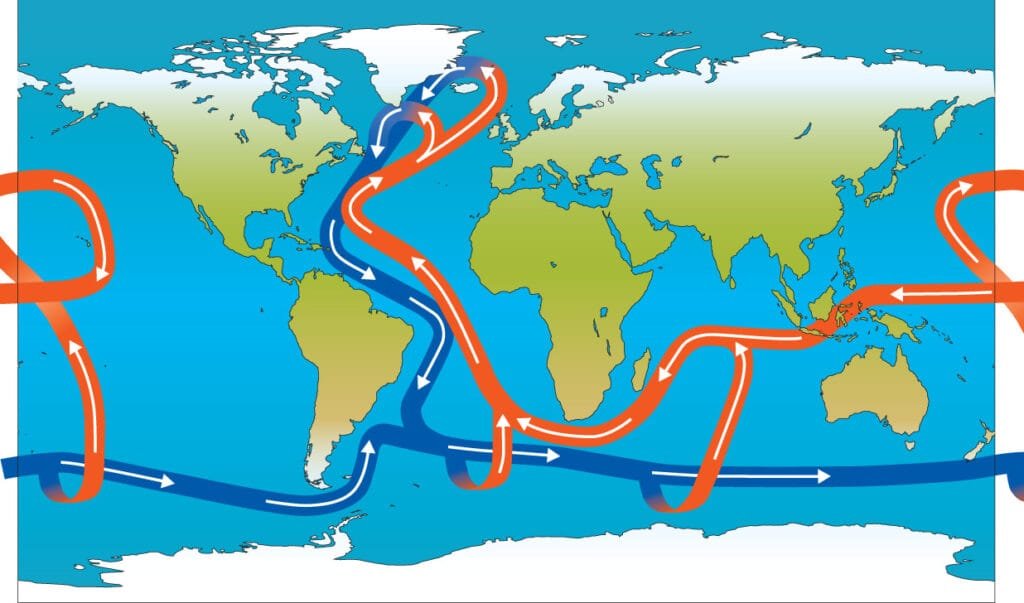The Atlantic Meridional Overturning Circulation (AMOC) plays an indispensable role in Earth’s climate system, acting as a planetary thermostat and a driver of weather patterns. Often described as the “ocean conveyor belt,” the AMOC moves warm surface waters from the tropics northward in the Atlantic, where they cool and sink before returning south at deeper ocean levels. This continuous cycle significantly impacts global temperatures, weather systems, and sea levels. However, evidence suggests that the AMOC is weakening—a development that could have far-reaching and potentially devastating consequences.

Understanding the AMOC: Nature’s Ocean Conveyor Belt
The AMOC is a critical component of thermohaline circulation, which relies on temperature and salinity gradients to drive ocean currents. As warm waters flow northward, they lose heat to the atmosphere, particularly in the North Atlantic, resulting in cooler, denser waters that sink and flow southward at depth. This process is why regions like Western Europe experience milder winters compared to areas at similar latitudes, such as northeastern North America.
To monitor this vital system, scientists deploy advanced observational tools, including the RAPID array at 26.5°N latitude. This system collects real-time data on ocean velocity, temperature, salinity, and pressure, enabling precise calculations of the AMOC’s strength, measured in Sverdrups (Sv). Do note that 1 Sv = 1 million cubic meters per second, that’s a lot of water! Additionally, reanalysis data like GloSea5 allow researchers to investigate past climate trends and better understand the AMOC’s behavior over decades.
AMOC Variability: Natural Oscillations or Human Influence?
The AMOC’s strength fluctuates across different timescales due to various factors:
- Short-term variability: Primarily influenced by atmospheric wind patterns that modify surface currents.
- Long-term variability: Driven by internal ocean dynamics and external climate forcings, such as greenhouse gas emissions and Arctic ice melt.
One of the most concerning trends in recent years is the observed weakening of the AMOC, a phenomenon linked to the warming and freshening of the North Atlantic. Melting Arctic ice and Greenland’s ice sheet introduce significant amounts of freshwater into the ocean, disrupting the delicate balance of salinity and temperature gradients needed to sustain the circulation. While natural variability can obscure the direct impacts of human-induced climate change, long-term datasets like RAPID and GloSea5 indicate a troubling downward trend in AMOC strength.

Why AMOC Weakening Matters
A weakening AMOC could trigger a cascade of climate and environmental consequences. Some of the most pressing concerns include:
- Disruption of Climate Patterns
- A weaker AMOC could cool Western Europe, paradoxically leading to harsher winters despite global warming. Meanwhile, the tropics may experience intensified heat, altering global temperature gradients.
- Shifts in rainfall patterns could lead to prolonged droughts in parts of Africa and South America while increasing flooding risks in others.
- Increased Weather Extremes
- The Atlantic hurricane season could become more severe, as a weaker AMOC allows warm waters to linger in the tropics, fueling storm development.
- Changes in ocean circulation could exacerbate monsoonal rainfall, disrupting agriculture and livelihoods in vulnerable regions.
- Economic and Social Impacts
- Cooler European winters could drive up heating costs, strain energy grids, and shorten growing seasons, affecting food security.
- Rising sea levels along the U.S. East Coast—partly attributed to AMOC weakening—could inundate coastal communities, necessitating costly adaptation measures.
What is the potential timeline for an AMOC collapse, and what could be its global consequences?
The Atlantic Meridional Overturning Circulation (AMOC) could collapse between the mid-2030s and the 2060s if greenhouse gas emissions continue at their current pace. A collapse of this critical ocean current system would have severe consequences, including extreme cooling in Europe, disruptions to monsoon systems in Africa and Asia, accelerated sea-level rise along the eastern United States, and increased frequency of extreme weather events globally. This emphasizes the urgency of significant reductions in emissions to prevent such a catastrophic outcome.
The AMOC: A Climate Tipping Point
The AMOC is widely regarded as a climate tipping point—a threshold beyond which small changes can lead to irreversible, self-reinforcing feedback loops. For example, a weakened AMOC could further accelerate Greenland ice melt, injecting more freshwater into the North Atlantic and amplifying the cycle. The implications of such a scenario are stark: rapid regional cooling, destabilized weather systems, and widespread economic disruption.
Skeptics may question how global warming could coexist with localized cooling in Western Europe, but this apparent paradox highlights the interconnectedness of Earth’s climate system. The heat trapped by greenhouse gases doesn’t disappear; instead, it redistributes unevenly, leading to complex regional effects.
Navigating the Uncertain Future of the AMOC
Preventing further weakening of the AMOC requires urgent action to mitigate global greenhouse gas emissions and address the drivers of Arctic ice melt. International collaboration and investment in climate research are essential to refine our understanding of this critical system and implement adaptive measures.
The AMOC’s fate underscores the interconnected nature of our planet. While it serves as a reminder of the consequences of inaction, it also provides an opportunity for collective efforts to safeguard the delicate balance of Earth’s climate.
PS: Here is another article I wrote on 101 Climate Change Impacts You Should Know.



